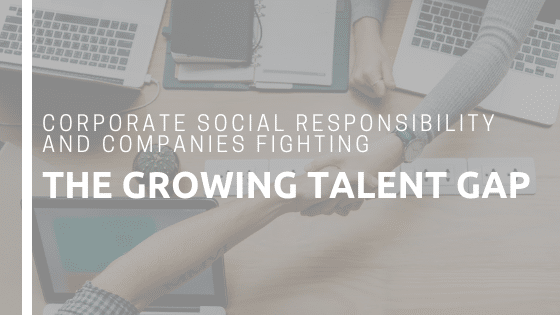Corporate Social Responsibility and Companies Fighting the Talent Gap
With the unemployment rate at a record low, companies continue to struggle to find and hire skilled talent from the workforce. This talent gap comes from two places: the ever-changing needs of the STEM fields, and the perception of vocational training.
“It is considered a second choice, second-class,” said Patricia Hsieh, president of San Diego Miramar College, during the annual AACC Meeting. “We really need to change how people see vocational and technical education.”
Vocational jobs are expected to grow, making the talent gap even larger. By 2025, trade positions are projected to account for 30 percent of California’s job openings –that’s a whopping 1.9 million jobs!
Companies that are fighting the Talent Gap
Some companies have taken notice that the up and coming talent market may not be large enough to replace those who are looking to retire in the next five years to ten years. Because of this, companies are becoming more proactive in their hiring process, and building their employer brand to attract the best talent when possible…and better train and prepare the younger generations for the future.
Delta’s Apprentice Program
Delta noticed an impending crisis filling future pilot and mechanic positions. To combat this gap, Delta is providing aviation classes in middle and high schools.
In the mechanical co-op, students go through rotations combining traditional learning and hands-on training with real airplane engines. This gives scholars the confidence to jump into the position.
It’s a win-win. Delta is also putting their name and company culture directly in front of talent and opening doors for future talent.
Chevron
The tri-state region of western Pennsylvania, eastern Ohio and northern West Virginia is growing out of their once-prosperous coal and steel industry. The area is changing into a leader in manufacturing, energy production and technology.
In 2012, a survey showed that several dozen companies were expecting to grow. They expected to hire 7,000 new employees by 2020, but feared a shortage of STEM skills in the local workforce. Therefore, Chevron joined forces with local organizations to create the Appalachia Partnership Initiative (API).
The API increased access to STEM Education, invested in resources for further development and provided scholarships for technical training programs. The long term program has provided hundreds of scholarships, instructor programs, and supported over 700 veterans re-entering the workforce.
“Supporting STEM and tomorrow’s workforce is critical to the success of our business. We strive to build lasting relationships to create progress and prosperity now and for generations to come,” said John S. Watson, CEO of Chevron Corporation.
Steelcase
 Steelcase is tackling the skills gap that is expected to result in 2 million unfulfilled jobs. Their solution? Phased Retirement Program and Skilled Trades Apprenticeship Program.
Steelcase is tackling the skills gap that is expected to result in 2 million unfulfilled jobs. Their solution? Phased Retirement Program and Skilled Trades Apprenticeship Program.
Starting with current employees, the Phased Retirement Program allows long-time employees to reduce their hours before retiring. During this time, they help train the next-generation workforce. The program is only available to people with 76 points or more (attained from age plus years of continuous service). Steelcase is able to keep their top performers longer, while having them teach new employees.
Targeting the next-generation, the apprenticeship educates employees who want to be future machine repairpersons, electricians and tool makers. The training requires 8,000 hours on-the-job and community college classes over four years. By the end of it, the apprentice receives journeyman status from the US Department of Labor. The best part? As long as grades remain above a C, Steelcase pays for classes and books!
The Talent Gap vs. Corporate Social Responsibility
The talent gap creates an issue for companies, but also creates the opportunity to help influence a young person’s career. With every gap in the talent market, comes a new generation that can be nurtured to fill it. Between classes, scholarships and apprenticeship program, companies are providing this generation of youth access to a bright future. And, these examples aren’t the only companies to start educational programs. Business Roundtable reported 66 companies who are making efforts to prepare current students to fill that gap.
Furthermore, corporate social responsibility is becoming a more important need for employee happiness. A Harvard Business Review article stated that there are three things employees really want. They want purpose, community and engagement.
Find Purpose
First of all, employees want to work with purpose. As these companies tackle the talent gap and build their corporate social responsibility, they are providing employees with purpose. Every employee and trainee is working to grow their skills and helping others grow their education too. Some companies are even “upskilling” their employees, which means they are helping them get higher training and promotions. This ultimately helps retain good employees longer.
Build Community
As for community, businesses are engaging students and young employees to feel confident in the work they are doing and building relationships in the company. These students are learning from the other employees, which creates a sense of belonging and respect.
Facilitate Growth
Finally, they are learning the ins and outs of a career and all the growth possibilities. Since the new employer has more confidence in their work, they can be more engaged and autonomous in their work.
The best way for employees to feel a sense of all three together is to ask them for their story. If the company is providing professional development, community, and engaging careers, then the stories will flow easily!
Overall, the companies who are fighting against the talent gap are also growing a strong employer brand. As a result the companies have plenty of students who are likely to end up working at the company. More importantly, the businesses are still helping those students who don’t build a future elsewhere, and they will still tell their journey with your company too!

